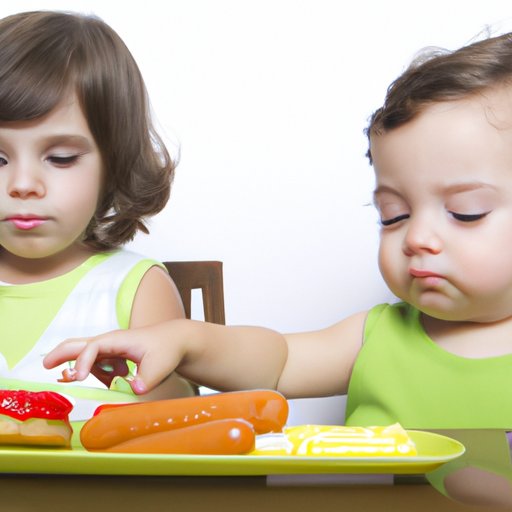Introduction
Meal times with toddlers can be a source of stress for parents. Toddlers are notorious for being picky eaters and refusing to try new foods. It’s important to remember that this is a normal stage of development and there are strategies you can use to encourage healthy eating habits in your toddler. This article will provide tips on how to get your toddler to eat.
Offer Variety
One of the best ways to get your toddler to eat is by offering a variety of healthy options. Research has shown that toddlers who have access to a wide range of foods are more likely to develop a taste for them. “It’s important to offer your child a variety of foods from all five food groups,” says pediatrician Dr. Karen Lee. “This helps to ensure that they get the nutrients they need.”
Offering a variety of foods can also help prevent picky eating. When children are exposed to different flavors and textures, they are more likely to try them. Some examples of healthy foods to offer your toddler include fruits, vegetables, lean protein sources, whole grains, and dairy products.
Let Them Help
Involving your toddler in meal preparation can be a great way to get them interested in eating. Allowing your toddler to help with simple tasks like stirring ingredients or tearing lettuce can help them feel involved and excited about trying new foods. “Children learn through experience,” explains Dr. Lee. “By involving them in the cooking process, you’re helping them build a positive relationship with food.”
You can also let your toddler help with grocery shopping. Taking them to the store and letting them pick out fruits and vegetables can be a fun way to get them interested in healthy foods. You can also involve them in meal planning by asking what they would like to eat for dinner.
Keep Meal Times Positive
Creating a positive atmosphere at mealtimes can also help encourage your toddler to eat. Avoid distractions like TVs and phones and focus on interacting with your toddler during meals. Make sure to praise them when they try new foods or finish their plate. You can also make mealtimes fun by creating themed dinners or playing games at the table.
It’s also important to be mindful of how you talk about food. Avoid labeling foods as “good” or “bad” and instead emphasize the importance of balance. “We want our children to understand that all foods can fit into a healthy diet,” says Dr. Lee. “By having a positive attitude towards food, we can help foster healthy eating habits in our children.”
Don’t Force Feed
It’s important to avoid pressuring your toddler to eat. Not only can this create an unpleasant mealtime environment, but it can also lead to unhealthy relationships with food. Instead, focus on providing a variety of healthy options and encouraging your toddler to try new things. If your toddler refuses to eat, it’s okay to take the food away without a fuss.
It’s also important to listen to your toddler’s hunger cues. Respect their appetite and don’t force them to eat if they’re full. “It’s important to trust that your child knows when to stop eating,” explains Dr. Lee. “Encouraging them to listen to their body’s signals can help them develop healthy eating habits.”
Try Finger Foods
Finger foods can be a great way to get your toddler to eat. Not only are they fun and easy to eat, but they are also a great way to introduce new flavors and textures. Some examples of healthy finger foods include diced fruits and vegetables, cheese cubes, boiled eggs, and whole-grain crackers. You can also make your own finger foods by cutting up sandwiches or slices of cooked meat into small pieces.
It’s important to remember that toddlers need to learn how to feed themselves. Letting them practice with finger foods can help them develop their fine motor skills and become more independent eaters.
Conclusion
Getting your toddler to eat can be a challenge, but there are strategies you can use to make mealtimes a positive experience for the whole family. Offer a variety of healthy foods, let your toddler help with meal preparation, and keep mealtimes positive. Don’t pressure your toddler to eat and try offering finger foods to help them learn to feed themselves. With patience and persistence, you can help your toddler develop healthy eating habits.
(Note: Is this article not meeting your expectations? Do you have knowledge or insights to share? Unlock new opportunities and expand your reach by joining our authors team. Click Registration to join us and share your expertise with our readers.)
